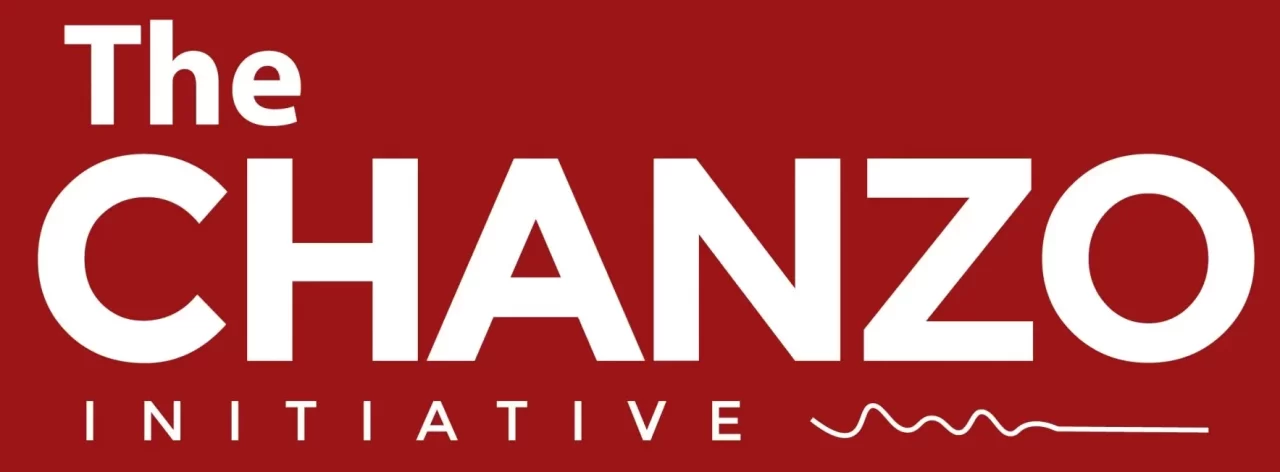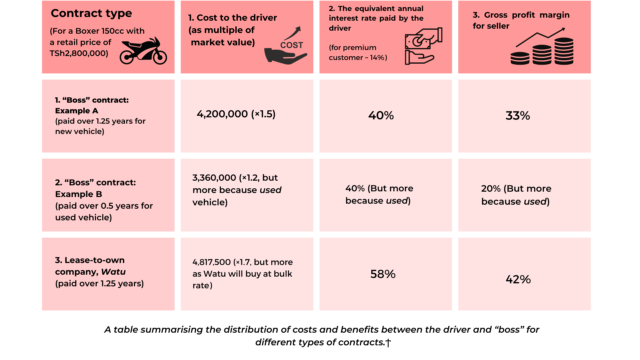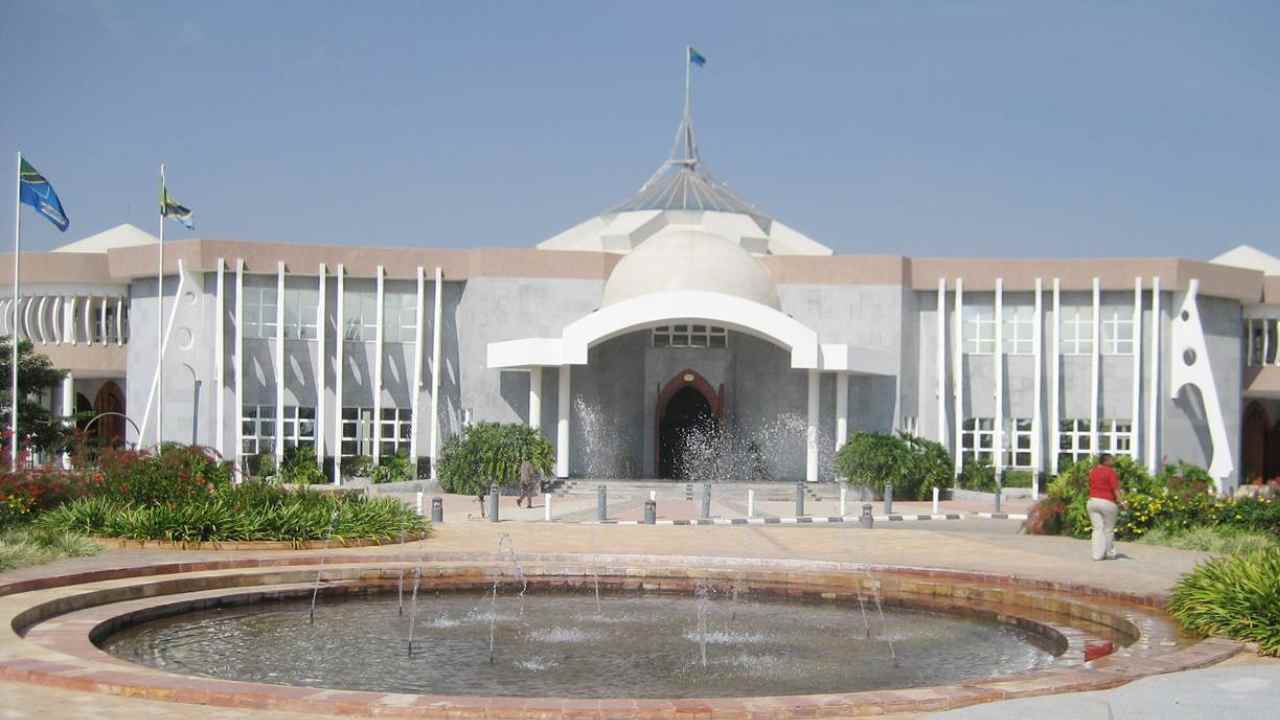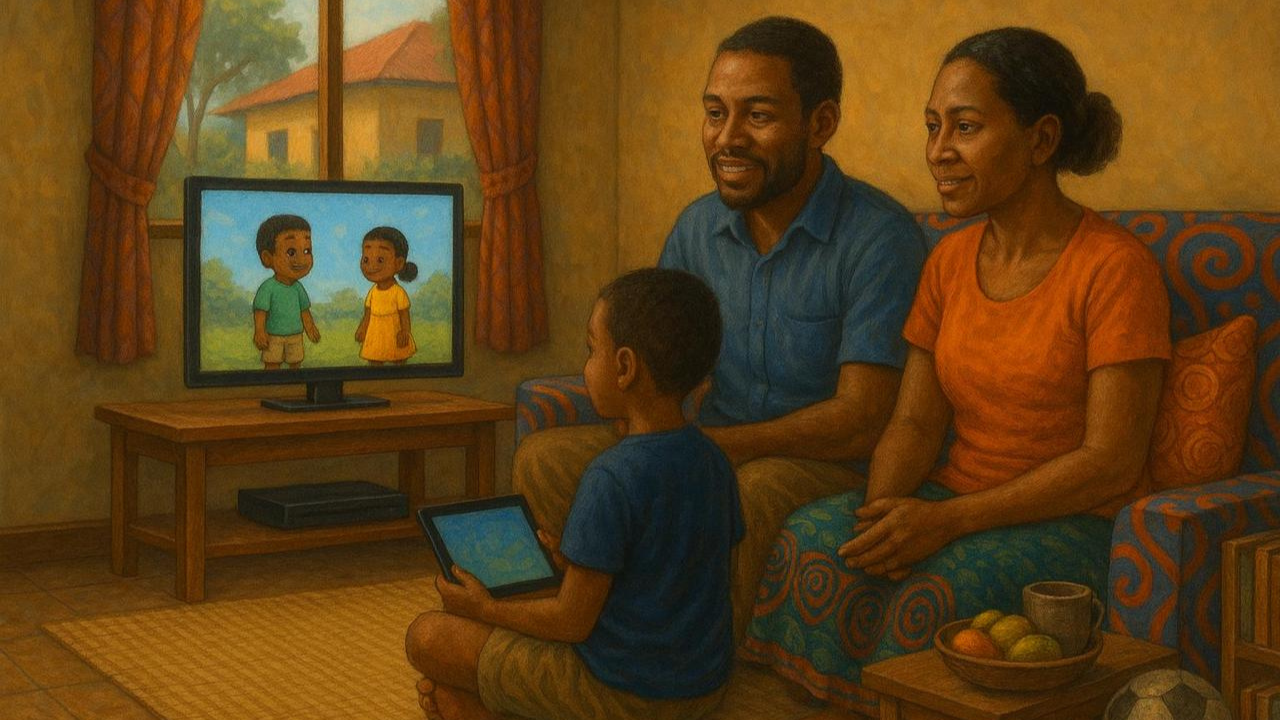“I’ve been driving for a long time now, and I still don’t own my own vehicle,” explains Abdu*, a motorcycle taxi or boda boda driver.
“I’m looking for any opportunity, maybe a contract [to pay towards buying a bike]. I would love that chance, so I can try to get ahead a bit in this life.”
Abdu—whose name I’ve changed to preserve anonymity—operates out of the now gentrifying neighbourhood of Sinza, 11 kilometres from Dar es Salaam’s central business district.
Fellow drivers at Abdu’s kijiwe—the stage where drivers park together awaiting passengers—echo his sentiment. We want “maendeleo” (development), says Darweshi*, but “the days keep passing by.”
Driving boda boda or bajaj—three-wheeled vehicles—is a growing source of employment in Tanzania’s commercial capital, where the saturated labour market leaves many with few options.
Responding to the sector’s rapid expansion, the Tanzanian government has since the 2010s sought to regulate boda boda and bajaj transport. It has also introduced various loan schemes, aimed especially at improving “youth” livelihoods.
Despite this growing significance and attention, there is still “very little that has been published on boda bodas [or bajaj] in Tanzania.” Some helpful exceptions stand out, but important questions remain.
How could driving be a more secure source of income, a means of “getting ahead?” And could the sector be organised to benefit both drivers and the wider urban transport system?
My aim here is to explore these questions while centring drivers’ own perspectives. Accordingly, the questions shift slightly.
What obstacles do drivers identify in their work? How do they organise to overcome these? And how—through their ideas and actions—are they transforming urban transport in Dar es Salaam? Can they contribute to a more inclusive transport system, one that is designed by and for the city’s many low-income residents?
To respond, I draw on interviews with drivers, focus group discussions, and documentary evidence, including drivers’ “contracts.” I gathered this material from July to September 2022 in two contrasting areas of Dar, the above-mentioned, more gentrified Sinza and the working-class commercial hub of Manzese.
Although this research is ongoing, I include here experiences shared by drivers thus far, namely details about: “exploitation” by “bosses”; drivers’ efforts to form associations; the fraught politics of formal recognition, which seemingly privileges capital accumulation and gentrification over livelihoods; and drivers own imagined alternatives, from cooperative ownership to more participatory planning.
Ultimately, at stake is not just driving as a source of livelihood, but an understanding of how to recognise and accommodate the contribution of Dar’s wavujajasho, its working poor, to the development of the city.
‘This work’
Before we delve into details, how do drivers summarise the pros and cons of their work?
For many, it is a valued source of livelihood.
It can be a step up from less lucrative forms of informal employment. Abdu switched from frying eggs and chips by the roadside to driving a boda boda, finding he was better able to support his family.
Darweshi once hawked mosquito nets, walking through traffic to sell to passing cars. At that time, he slept in the street, but after taking up driving thanks to help from an uncle, he rented his first room, then another room with electricity. Next, he bought a mattress, then a bed, “until now, I can take care of myself,” he says.
Driving can also be a fallback for those who lose formal employment. Benji trained in marketing and worked for a communications company until financial difficulties forced the company to lay off staff, including Benji.
Because he was “from a poor family” (familia duni), he was left wondering, “how will I get by?” Driving proved to be his way out.
Some drivers do more than “get by” from the income they earn. For instance, a few individuals interviewed had bought plots of land on the peri-urban outskirts of Dar es Salaam, commuting into the more commercial area from which they operate.
But even for these more successful drivers, there are limits. Emmanuel*, who is raising a young family, has his plot of land, “but I haven’t managed to build [a house] yet because of this work.”
Drivers may value “this work” for the livelihood it provides, but as Emmanuel’s phrase implies, they also lament its many setbacks, some so taken-for-granted there is no effort to enumerate.
But the list is long.
Near the top are accidents, healthcare costs, and the long-term consequences. James is a wiry 30-year-old quick to crack a joke.
But his near-constant laugh falters when he recalls the collision that left him with a “body full of metal” and an accompanying burden of debts.
Other drivers show their own scars, voicing a shared desire for health insurance, a would-be answer to physical as well as psychological and financial pressures.
Health aside, the list continues: police harassment, routine arrests, and extortion through bribes; the expense and difficulty of getting licenses, paying for vehicle insurance, registering an association, of accessing loans; the fear of assault and vehicle theft; the widespread stigma such that drivers are seen as “rogues,” “thieves,” “insects.”
From this array of issues, some more structural constraints emerge, a set of consistent obstacles whose removal could, drivers insist, transform their prospects.
More than a means of getting by, “this work” could instead fulfil commonly expressed hopes for “development”.
Everyday exploitation
A common perception is that workers in the informal economy—including drivers—are self-employed. Yet the reality is not so straightforward. Informal labour, in its various forms, is structured by social relations of exploitation and “accumulation by dispossession”.
For drivers, their main preoccupation is their relationship with “mabosi,” their bosses, or their “tajiri,” the rich person. Because few own their own vehicles, they instead pay a daily or weekly rate (hesabu) to this “boss,” i.e., the owner.
Drivers routinely denounce this “oppression,” identifying it as the exploitation of labour by capital.
“[The boss] goes to the bank. He borrows two million with his good conditions [as in, the advantageous terms afforded a premium customer],” one driver observed. “He buys vehicles. He gives them to the drivers. Us drivers are then the ones who pay back his bank loan, which he finishes and, on top of that, keeps a big profit.”
The result, as summarised by another driver, is that “we progress far more slowly than our bosses.”
But how much does the “boss” benefit? Can we put a number on it?
The answer depends on the form of the owner-operator relationship. Some drivers pay a weekly rate without any prospect of owning the vehicle at the end.
Alternatively, they enter a “contract” with their boss whereby they agree on an amount to pay in instalments and, at the end of a set period, own their vehicle.
A third arrangement resembles the second, but instead of paying an individual boss, drivers pay a lease-to-own company, an increasingly popular business venture in Dar es Salaam.
For drivers without any form of contract, a common rate paid to the boss is Sh15,000 per day, or Sh105,000 per week with the boss then responsible for covering repairs.
This leaves drivers with an estimated Sh50,000-70,000 take-home, but many stress the uncertainty even of this “little.” There is always variation week-on-week. Moreover, an accident, an illness, a bereavement, or any similar disruption entails a significant loss of income.
Meanwhile, the cumulative payments to the boss keep mounting. Take again, for example, Abdu’s experience. He reports paying Sh15,000 per day, sh105,000 a week for 11 years.
Assuming conservatively that he worked an average of 40 weeks per year, having missed some weeks, then he has paid upwards of Sh46 million to a boss—not necessarily the same one—during his driving career.
This figure gives us a sense of the transfer of wealth involved in driver-to-boss payments. Forty-six million is enough to invest in land for a house to replace Abdu’s current rental property, or in a sizeable fleet of motorcycles, or any number of other business ventures.
As it is, Abdu—like most drivers—is ineligible for a loan, so he continues to pay what capital he might otherwise accumulate to his tajiri.
Understandably, then, many drivers want to agree on a contract so that at least they are working “towards something,” i.e., their own vehicle. But the terms of these contracts come with their own challenges.
The below table summarises the distribution of costs and benefits between the driver and “boss” for different types of contracts. The first two rows show examples of actual agreements between drivers and individual bosses.
The third row shows the terms of a lease-to-own company, cheerfully branded Watu, or “People.” All three contracts are for the purchase of a Boxer 150cc motorcycle, a popular make.
In each case, we can see that drivers pay significantly more than the retail price of the vehicle, an estimated Sh2,800,000.
If we liken drivers’ total payments to the purchase of the vehicle at retail price plus interest, then they also pay a high equivalent annual interest rate, between 40 and 58 per cent.
This is significantly higher than a “boss” or lease-to-own company would pay a Tanzanian bank, with interest rates reportedly 14 per cent for premium customers in August 2022.
Finally, “bosses” benefit from a seemingly healthy gross profit margin, i.e., between 20 and 42 per cent.
While still only rough calculations, these figures offer some numerical validation of drivers’ own perception, namely that a disproportionate share of their labour goes towards profits for the boss.
What is more, there are further advantages for bosses—and losses for drivers—that cannot be captured in a table.
For instance, Benji*, the driver who agreed to the “example A” contract for Sh4,200,000, fell behind in his payments after eight months. “I missed a day here and there until the debt reached Sh200,000,” he says.
He stresses how relentless the repayment schedules can be. Drivers cannot afford “to run into a problem, even one,” he says, for fear of falling behind.
Although Benji had already paid approximately Sh2,040,000, the “boss” reclaimed his vehicle without compensation. Benji tried to contact the lawyer who witnessed the contract signing, but it was “the boss’s lawyer.”
The contract also contained no provisions for compensation of the driver, only for confiscation by the boss, and Benji did not have the means to pursue the case further.
He later learned that his boss—who had purchased the bike at a reduced wholesale price as part of a bulk order—had resold the now-used vehicle. Other drivers insisted this pattern of behaviour—confiscation and reselling of contracted vehicles—is common among bosses.
Denis*, the driver in “example B”, did finish his contract. But he paid well above the retail price for a new bike, yet his was already used and quickly broke down.
When I spoke with him, he was driving a friend’s vehicle. He used it during the day while the friend took the busier night shift.
Of the three examples, the lease-to-own company offers the worst terms for drivers, at least on paper.
These companies only recently surfaced in Dar but are widespread in comparable regional cities like Nairobi and Kampala. Some critics highlight the poor terms, but other observers—not to mention the companies themselves—suggest they “empower” drivers to own, or else present a neutral view.
In Dar, drivers are sceptical.
“Lots of young guys go [to Watu] because it’s quick [to get a vehicle],” explains Othman, a seasoned driver. “But if you fail to repay, within one week they come to take your bike and resell it.”
Watu is not the only company, either.
“They have discovered this business, and there are many now,” Othman says. “They are exploiting those young guys.”
Collective action: A way out?
One strategy drivers adopt to improve their work conditions—including to escape “exploitation”—involves forming associations.
Informal organising among drivers is ubiquitous. As mentioned earlier, drivers form vijiwe, or stages, controlling who can operate from a given parking area. These groups sometimes create savings schemes as well.
These schemes may serve as a form of insurance, for instance, contributing to a member’s healthcare costs after an accident. Drivers may also use their savings to buy vehicles or invest in income-generating projects.
However ambitious their aims, drivers’ informal organising ensures a degree of security in their work. As a form of (self)regulation, it also contributes to a more orderly transport system.
It results in clearly identifiable parking areas, helps foster mutual accountability among drivers, and makes it easier for passengers to find drivers they trust.
Despite its benefits, though, this informal organising often lacks formal recognition. Herein lies a fresh obstacle for drivers.
Drivers may seek to register an association. This involves, first, gaining official recognition for their parking area, thus reducing the risks of displacement. Drivers can also better access various government loan schemes, open bank accounts, and the like.
But efforts to register associations are often unsuccessful. The contrasting experiences of drivers in Sinza and Manzese—the earlier-mentioned gentrifying and more working-class areas—help reveal why.
One important—and often overlooked—factor is that drivers’ success partly depends on whether their efforts align with the interests of local businesses.
Investors arriving in an area can influence the behaviour of local officials in a way that drivers often cannot. Amidst a micro-politics of state-capital bargaining, the welfare of drivers’—and informal labour more generally—hangs precariously in the balance.
How, then, does the Sinza-Manzese contrast help illustrate this point?
In Sinza, a group of drivers was itself approached by the relevant authority, in this case, the elected chairperson of the Serikali ya Mtaa, or “street government.”
A drivers’ stage had existed in the same location since at least 2015, according to some of its long-time members. But it was never formally recognised; rather, successive mtaa chairpersons complained that the stage was on the roadside and leading to congestion.
The change in attitude came after a new investor refurbished a local bar, turning it into a popular new venue. The bar management and the local mtaa chairperson agreed that the business required secure transport for customers, prompting the official effort to formally register the drivers’ association.
The group—now comprising 40-odd members—leapt at the opportunity to strengthen their organisation and improve their collective incomes.
In an effort to build trust with customers, they purchased reflective vests and emblazoned them with the name of their association and the assigned number of each individual driver.
They also formalised their structure and agreed on a constitution; they determined a set of rules for how to serve the bar at night in an orderly way; and they began contributing to a savings scheme with further hopes of accessing loans offered by the municipal government.
While internal divisions meant that the savings scheme did not last, the other features of the organisation did endure, with drivers reporting a significant improvement in their incomes.
A smaller sub-group within the “mother” group also re-launched its own savings scheme, the aim being greater economic independence, including through cooperative ownership, a theme I return to shortly.
Meanwhile, nearby Manzese is an important commercial hub, but drivers parked along the busy Morogoro Road mainly serve low-income customers. There are no high-grossing businesses taking a particular interest in drivers’ services, no trendy new bars to strengthen their bid for formal recognition.
The consequences are clear-cut, as explained by Muddy*, the chairperson of one drivers’ stage. His group decided to register formally after the government announced a new loan scheme that required registration as a pre-condition for access.
“The registration process is far too long,” Muddy insisted, not to mention “expensive.” His group had to pay an initial Sh50,000 to draft their constitution, another charge at the local street government offices, and “elsewhere other charges too.”
Yet in the end, the mtaa chairperson refused to formally recognise their parking area, claiming it was “in the road” and would need to move. But for Muddy and other drivers, moving someplace “out of the way” is not realistic.
“That place is where we can make some money, so if you remove us from there, how will it be?” he asks.
Whereas the mtaa chairperson in Sinza overlooked that drivers there also parked alongside the road, his counterpart in Manzese held firm, refusing to recognise drivers’ parking area.
Muddy’s group thus could not register their association nor access their loan. They remain parked where they were before.
Although still officially unrecognised, they are part of the fabric of the surrounding neighbourhood, purchasing from local food vendors, relying on the informal roadside mechanics for repairs, and in turn, providing transport services to passing customers.
Towards ‘development’?
We began by asking, what are among the biggest obstacles drivers face? How might these be overcome? How could driving be a secure source of livelihood? And how could it contribute to Dar es Salaam’s evolving urban transport system?
To recap, drivers highlight how their work means they can support themselves and even their families. But they struggle to “get ahead” (kupiga hatua), or to “develop.”
Routine payments to “exploitative” bosses undercut their efforts to accumulate and invest. Drivers’ collective efforts to improve their income—and to save and invest together—are also complicated by the politics of formal recognition.
Widely perceived as “unplanned” and a “problem,” drivers’ activities only intermittently receive a formal sanction from relevant authorities.
Moreover, at least in Sinza and Manzese, it seems that local officials care less for the livelihoods of drivers themselves than for the value they may add to local business, i.e., whether they help advance processes of capital accumulation and gentrification.
So, what could be different? This is a big question, but a few concluding points bear mentioning.
Drivers themselves are imagining—and sometimes enacting—alternatives. For instance, the group of drivers in Sinza that has re-launched its savings scheme has a vision of collective “development” through cooperative savings and ownership.
They want to buy bikes to own and use in common, generating revenue to purchase more bikes. They also want to invest in a co-operatively owned spare parts business, selling to themselves and other drivers.
While still an embryonic project, it is a “way forward”, according to members. “Umoja ni nguvu, utengano ni udhaifu,” or “unity is strength, isolation is weakness.”
More fundamentally still, drivers have already transformed transport in Dar es Salaam, as noted above. Although “unplanned” in the formal sense, their contribution is an organic response to the needs of Dar residents to quickly traverse an often-congested city or to cover that “last mile” from the bus stop to home.
By organising into “stages,” drivers also ensure a degree of order and accountability in the transport service they provide.
However, the upscaling of drivers’ cooperative ambitions, or official recognition of their contribution to urban transport, requires a new policy approach, one that better accommodates bottom-up initiatives.
Authorities from the street up to the city and national level can begin to rethink “participation as planning,” recognising how the everyday practices of informal operators like drivers are part of the evolution of Dar’s transport.
City officials have tended to oscillate between tolerance and repression of informal activities, be it driving, street vending or similar. But they could instead develop new strategies—or redevelop some old ones—to integrate this everyday practice of informal operators into formal planning processes.
One early step could involve introducing new procedures to recognise drivers’ parking areas, balancing the need to avoid congestion with an appreciation that drivers cannot be relocated “out of the way.”
Many will have already—through trial and error—struck this balance when establishing their stages. With a minimum of political will and facilitation, these could then be formally accommodated.
Another early focus could be improved support for drivers’ organising efforts, including their cooperative ambitions. As mentioned, drivers trying to register an association raise concerns about arbitrary requirements and undue expense.
Some urban co-operatives—not just of drivers—also observe that official support for co-ops mainly targets the “elite” Savings and Credit Cooperative Organisations of public sector entities and private companies.
Members of one all-women worker co-op in Manzese complained that they were made to pay several hundred thousand shillings to attend a mandatory training session where they were expected to work off laptops, despite lacking IT skills.
This is clearly not the kind of support that urban co-ops for traders, drivers, porters, welders, or waste-pickers can benefit from.
A host of other interventions could help support drivers, not to mention other low-income workers in Dar’s large informal economy. For instance, the continued movement towards Universal Health Insurance or regulation of the burgeoning lease-to-own industry could lighten their economic burden.
Arguably most fundamental, though, is for decision-makers to recognise drivers’ contributions, appreciate their experience, and respect their ideas.
These ideas can then inform approaches to policy and urban planning that enable the inclusive development of Dar es Salaam, catering for the wellbeing of its wavujasho, that is, its working poor.
*Not their real names.
Ϯ The figures in this table come from a range of sources, including a price comparison of motorcycle retailers in Dar, conducted in August 2022; drivers’ signed contracts; interviews with drivers; product information supplied by Watu at their Mwenge offices; BoT data on commercial bank interest rates; and my own calculations.
Michaela Collord is an Assistant Professor at the School of Politics and International Relations, at the University of Nottingham, UK. She can be reached at Michaela.Collord@nottingham.ac.uk or on Twitter as @MCollord. Do you want to publish in this space? Contact our editors at editor@thechanzo.com for further clarification.





